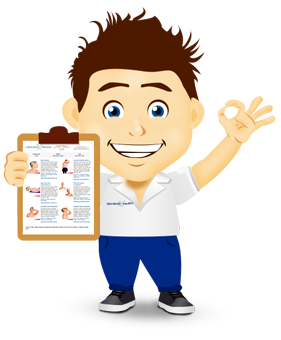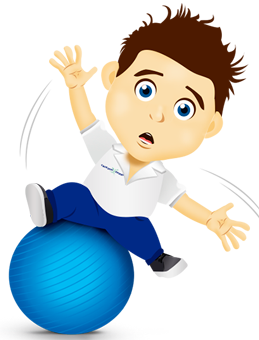
Next steps:
Feel free to read the advice sheet below! To get the full benefit click on 'Start treatment'. By starting the treatment you will get access to weekly rehab programmes online for FREE. You will be able to track your progress, pain levels and we will remind you to do your exercises every day!
Upper back pain is common, although less prevalent than lower back pain. Typically pain is caused between the shoulder blades. The pain can be felt across the shoulders, upper back, shoulder blades and ribs. Sometimes the pain can travel around to the front of the chest, although this is unusual. Pain may be one sided, or both sides, or central.
What Causes Thoracic Spine Pain?
- Repeated forward bending – places load on the discs which can cause degeneration and place stress through the facet joint.
- Poor posture.
- Sudden twisting movements if the spine is stiff.
- Hypermobility in the spine: if the spine is unstable, joints can become sprained.
The most common cause of upper back pain is poor posture. If you hold your upper back in a forward bent position for long periods of time, it will typically cause strain through the joints and muscles, leading to upper back pain. Maintaining good upright posture reduces the effects of gravity on your spine and helps reduce pain.
Thoracic Spine Anatomy
The spine is composed of a number of small bones, referred to as vertebrae, which are all stacked one on top of the other. Ligaments, nerves, muscles and intervertebral discs are all additional components of the spine. In the thoracic spine there are twelve vertebrae, labelled T1 to T12.
Vertebrae connect together via the facet joints to create a canal that shields and protects the spinal cord. It is composed of three distinct sections creating natural curves in your back: chest area (thoracic), curves of the neck area (cervical) and lower back (lumbar). The lower part of the spine is composed of vertebrae fused together. Five lumbar vertebrae join the pelvis and the spine together.
There are 12 ribs and they attach into the side of the vertebrae of the thoracic spine.
Spinal nerves travel along the spinal canal to carry messages between the muscles and the brain. The nerves will branch out from the spinal cord out of the vertebrae openings.
How to Treat a Thoracic Spine Pain:
- Rest and Recover
If the pain is very acute, rest and let it settle for a couple of days before engaging in sport or activities. You can still go to work, just take it easy while the pain settles. Most of the time pain does reduce. Exercises including mobility exercises can be done fairly soon after the injury however.
- Ice or Heat
Apply ice or heat to the affected area for 5-10 minutes at a time three to five times per day to help with pain and inflammation. Make sure to wrap the ice in a thin towel to prevent an ice burn from occurring on the skin. Try either ice or heat and see if they help. Patients often report good improvement with repeated use.
- Maintain Good Posture
Poor posture or regular forward bending is a big problem and causes a lot of back pains. Maintain good posture and minimize forward bending. Practicing extension exercises may also help to correct posture problems, and you can discuss this with your therapist. - Physical Therapy or Manipulation
Physical therapy mobilisation or osteopathic and chiropractic manipulation tends to be very successful for the facet joint pain in the upper back. The joints become looser as the stiffness reduces from the treatment. Muscle spasm can be massaged and reduced. - Stretching
Hold stretches for about 20 to 30 seconds each in sets of three. Make sure you begin with a 5-10 minute warm-up on an exercise bike or walking before you start stretching. Only hold the stretch at the first tension point. Make sure to go slow and gentle when first stretching. You don’t want to have any discomfort of excessive tension during the stretching routine. Discuss the stretching plan with your therapist for specific instructions.
Tips:
- Make sure to maintain proper posture at all times to prevent placing an undue amount of pressure on the spine.
- Leading a sedentary lifestyle is one of the worst things you can do as it causes the muscles and joints to become weak and stiff.
- Whenever lifting an object, make sure to lift it with your legs and not your back to prevent injury from occurring.
- Tightness and weakness in the muscles can cause injuries to occur.
- Exercising and building a solid core is important to helping maintain strength and flexibility in your back and spine.

